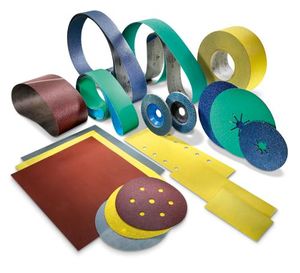Abrasives: Difference between revisions
From DT Online
m (Added single quotes) |
(Improved presentation and added note) |
||
| Line 1: | Line 1: | ||
[[File:Abrasives.jpg| | [[File:Abrasives.jpg|300px|right]] | ||
[http://en.wikipedia.org/wiki/Abrasive '''Abrasive papers'''] and cloths are used for finishing wood metal and plastics. Various abrasive grits, including emery, garnet, sandstone, glass powder and silicon carbide, are graded by passing through sieves. The [http://en.wikipedia.org/wiki/Sandpaper#Grit_sizes '''grit size'''] is given as the sieve mesh size per inch - low numbers for coarse and high for fine. | [http://en.wikipedia.org/wiki/Abrasive '''Abrasive papers'''] and cloths are used for finishing wood metal and plastics. Various abrasive grits, including emery, garnet, sandstone, glass powder and silicon carbide, are graded by passing through sieves. The [http://en.wikipedia.org/wiki/Sandpaper#Grit_sizes '''grit size'''] is given as the sieve mesh size per inch - low numbers for coarse and high for fine. | ||
Commonly used types are: | Commonly used types are: | ||
{| | {| | ||
|- | |- | ||
|'''[[Glasspaper|Sandpaper]]''', '''[[Glasspaper]]''' and '''[[Glasspaper|Garnet papers]]''' | |'''[[Glasspaper|Sandpaper]]''', '''[[Glasspaper]]'''<br /> and '''[[Glasspaper|Garnet papers]]''' | ||
| - used dry mainly for sanding of wood | | - used dry mainly for sanding of wood and coarse grades can be used also for paint removal. | ||
|- | |- | ||
|'''[[Wet or Dry Paper|Silicon Carbide]]''' | |'''[[Wet or Dry Paper|Silicon Carbide]]''' | ||
| Line 14: | Line 14: | ||
| - used dry principally to polish metals - especially steel. | | - used dry principally to polish metals - especially steel. | ||
|} | |} | ||
---- | |||
<span style="color: green">'''Note:''' | |||
When working through the grades of abrasives to achieve a fine finish, always try to work across scratches left by the previous grade. When sanding wood this may also mean working at alternate diagonals to the grain and finishing last of all with the grain. ''(To understand this, think that a river running through a valley may make it more rounded, but it deepens it : it does not remove it!)'' | |||
</span> | |||
<span style="color: green"> | |||
When finishing flat surfaces, and especially edges, it is best to support the paper or cloth in some way - for example: glass paper can be wrapped around a cork sanding block; wet or dry paper may by fixed to a piece of waterproof ply and emary cloth may be wrapped around a file ''(also oil may be added to emery cloth to improve the final finish)''. | |||
</span> | |||
---- | |||
[http://en.wikipedia.org/wiki/Steel_wool '''Fine Steel Wool'''] can also be used to produce a finish on metals or loaded with [http://en.wikipedia.org/wiki/Beeswax '''beeswax'''] to cut back varnish on wood. Liquid [http://en.wikipedia.org/wiki/Cutting_compound '''cutting compounds'''] and metal polishes are also mild abrasives, as are [http://en.wikipedia.org/wiki/Pumice '''Pumice'''] and [http://en.wikipedia.org/wiki/Iron%28III%29_oxide#Polishing '''Jewellers' Rouge''']. | [http://en.wikipedia.org/wiki/Steel_wool '''Fine Steel Wool'''] can also be used to produce a finish on metals or loaded with [http://en.wikipedia.org/wiki/Beeswax '''beeswax'''] to cut back varnish on wood. Liquid [http://en.wikipedia.org/wiki/Cutting_compound '''cutting compounds'''] and metal polishes are also mild abrasives, as are [http://en.wikipedia.org/wiki/Pumice '''Pumice'''] and [http://en.wikipedia.org/wiki/Iron%28III%29_oxide#Polishing '''Jewellers' Rouge''']. | ||
[http://en.wikipedia.org/wiki/Flapwheel '''Flap Wheels'''] and [http://en.wikipedia.org/wiki/Flapwheel '''Flap Discs'''] comprise multiple overlapping small pieces or ''flaps'' and are used for metal finishing. | [http://en.wikipedia.org/wiki/Flapwheel '''Flap Wheels'''] and [http://en.wikipedia.org/wiki/Flapwheel '''Flap Discs'''] comprise multiple overlapping small pieces or ''flaps'' and are used for metal finishing. | ||
Revision as of 19:01, 25 November 2014
Abrasive papers and cloths are used for finishing wood metal and plastics. Various abrasive grits, including emery, garnet, sandstone, glass powder and silicon carbide, are graded by passing through sieves. The grit size is given as the sieve mesh size per inch - low numbers for coarse and high for fine.
Commonly used types are:
| Sandpaper, Glasspaper and Garnet papers |
- used dry mainly for sanding of wood and coarse grades can be used also for paint removal. |
| Silicon Carbide | - commonly known as ‘wet or dry paper’ and used for general finishing of metals and plastics |
| Emery Cloth | - used dry principally to polish metals - especially steel. |
Note: When working through the grades of abrasives to achieve a fine finish, always try to work across scratches left by the previous grade. When sanding wood this may also mean working at alternate diagonals to the grain and finishing last of all with the grain. (To understand this, think that a river running through a valley may make it more rounded, but it deepens it : it does not remove it!)
When finishing flat surfaces, and especially edges, it is best to support the paper or cloth in some way - for example: glass paper can be wrapped around a cork sanding block; wet or dry paper may by fixed to a piece of waterproof ply and emary cloth may be wrapped around a file (also oil may be added to emery cloth to improve the final finish).
Fine Steel Wool can also be used to produce a finish on metals or loaded with beeswax to cut back varnish on wood. Liquid cutting compounds and metal polishes are also mild abrasives, as are Pumice and Jewellers' Rouge.
Flap Wheels and Flap Discs comprise multiple overlapping small pieces or flaps and are used for metal finishing.
